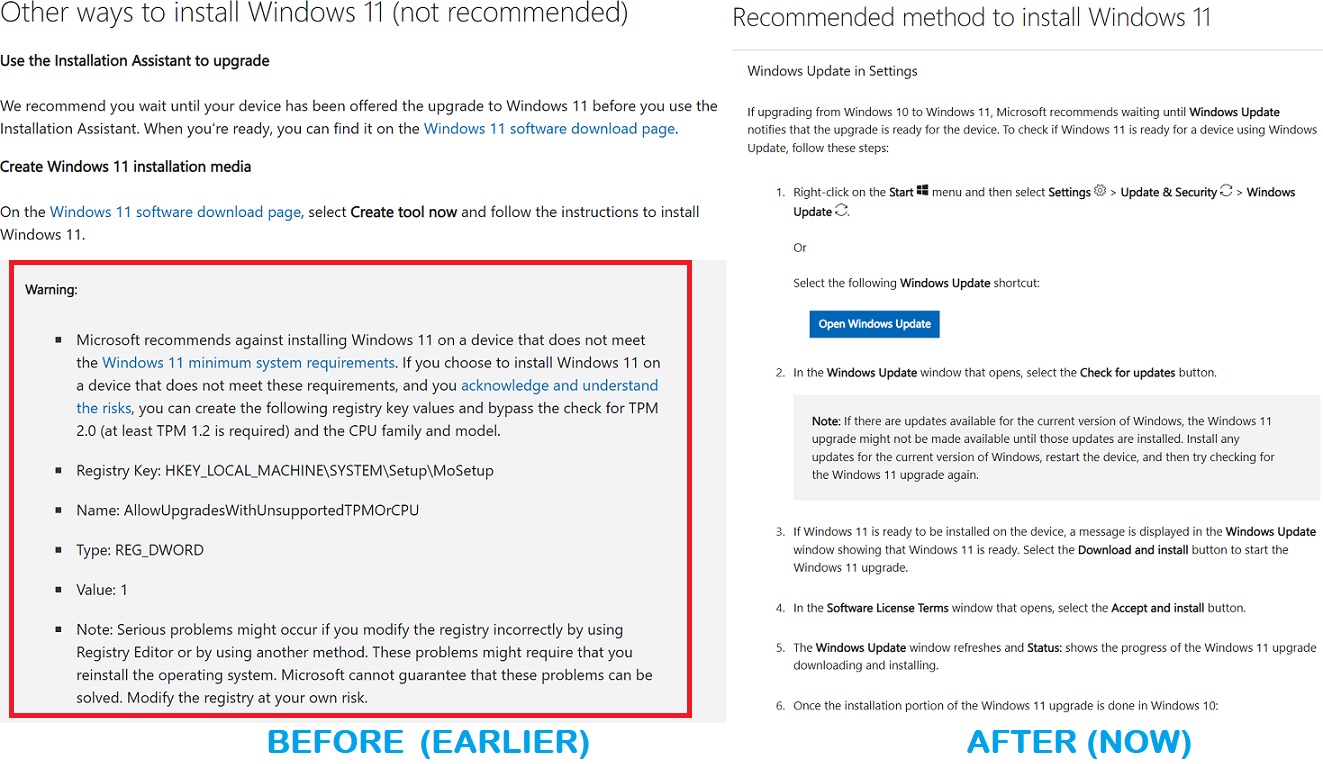Microsoft has quietly updated its support documentation to remove the Windows Registry code that allowed you to install Windows 11 on unsupported Windows 10 PCs. In a statement to Windows Latest, Microsoft clarified that the Windows 11 system requirements are unchanged, but you should go back to Windows 10 if you have an unsupported PC.
It goes without saying that Windows 11 has stricter hardware requirements than Windows 10, so it’s not recommended to upgrade most of the older hardware, including devices “designed for Windows 10 in mind”.
To install Windows 11, a PC must have 4GB of RAM, 64GB of storage, and DirectX 12 for graphics, but the major change is the requirement of TPM 2.0 (security chip) and UEFI with SecureBoot.
Most of the devices are missing out on official Windows 11 support because they do not have TPM 2.0-capable hardware. Windows 11 also does not support Legacy BIOS, so you’re left with no option but to switch to UEFI with SecureBoot, which requires a lot of effort, especially when you’re not familiar with the concept.
Since Windows 11’s announcement, Microsoft has recommended users against using unsupported PCs. At the same time, Microsoft’s support document has always offered a how-to section with steps to install Windows 11 on unsupported PCs.
It was all good until the last week of January 2025, when Microsoft quietly updated the support document to remove the guide.

Microsoft doesn’t want to explain its decision, but the company still offered some explanation when we reached out.
In a statement to Windows Latest, a Microsoft spokesperson confirmed that the requirements of Windows 11 remain changed and the bypass still works, but the company will not be recommending it anymore.
“At the time of publication and still today, the intention behind this support page is to detail ways of installing Windows 11 on devices that meet system requirements for Windows 11,” Microsoft noted in a statement.
But what if you already use Windows 11 on an unsupported Windows 10 PC that does not meet the TPM 2.0 requirements? “Immediately go back to Windows 10”, the company told us when we asked, and it once again didn’t offer any explanation.
“If you installed Windows 11 on a device not meeting Windows 11 system requirements, Microsoft recommends you roll back to Windows 10 immediately. Windows 11 minimum system requirements remain unchanged and can be found in the article Windows 11 specs, features, and computer requirements,” the company said in a statement.
Beyond the above details, Microsoft has nothing more to share.
While Microsoft no longer recommends the bypass and has removed the section from its documentation, you can keep using Windows 11 on any PC.
In fact, you can still follow the official bypass guide to install the OS on older PCs:
- In the Registry Editor, go to HKEY_LOCAL_MACHINESYSTEMSetupMoSetup
- If the MoSetup folder doesn’t exist, right-click Setup folder, create a new key and name it MoSetup.
- Inside MoSetup, right-click in the empty space and select New → DWORD (32-bit) Value.
- Name it “AllowUpgradesWithUnsupportedTPMOrCPU”
- Set Value data to 1, and click OK.
A Microsoft source confirmed that nothing has changed technically, which is why the above official instruction still works. Windows Latest has tested the above steps with Windows 11 24H2, and we were able to install it on an unsupported PC without significant problems.
I’m also told that Microsoft does not plan to prevent Windows 11 on older PCs. Microsoft is still warning that unsupported PCs may not receive security updates in the future, but we are not seeing anything in that direction.
The post Microsoft doesn’t want you to bypass Windows 11 requirements on Windows 10 appeared first on Windows Latest
